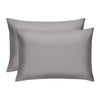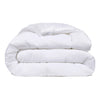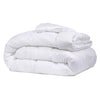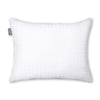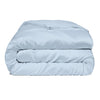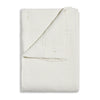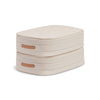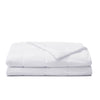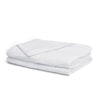The Daily Miracle
Does Cotton Shrink?
Published
November 17, 2022
Author
Bridget Reed

Cotton is one of the most popular fabrics in the world. It is versatile, comfortable, and can be made into hundreds of items. From t-shirts to towels and bed sheets to sweats, it’s almost impossible to go a day without using something that contains cotton. So, how do you care for this material? Is it easy to keep in good condition, or is it high maintenance?
We’ll cover some of the basics of what cotton is, how to care for it, and answer important questions like “Does cotton shrink?”
Does Cotton Shrink?
Yes, cotton does shrink. However, it is not a hopeless situation. There are a few simple ways to prevent cotton from shrinking if you spend time caring for it well.
Cotton typically shrinks the very first time it is washed, and it also can shrink when exposed to hot water temperature or high heat setting in the dryer. Almost all materials we use for our clothes and sheets can shrink if you do not care for them properly, so don’t let this fact scare you away from using cotton.
Why Does Cotton Shrink?
Cotton shrinks when the fibers lose tension due to heat and use. Why is there tension in cotton? To understand more about how cotton shrinks, it is important to know where it comes from.
What Is Cotton?
Cotton is a natural fiber that comes from the cotton plant. You can likely bring the image of a cotton plant to your mind right now: It is fluffy and white.
This plant then goes on a journey to become the items we use every day. Its use dates back to at least 5,000 B.C., with some of the oldest cotton found in Mexico. It was popular throughout the Middle Ages and continues to be used widely across the world today.
How Are Cotton Materials Made?
From the fluffy white bolls to your favorite pillowcase, there’s a lot of work involved.
It involves a few steps, which we’ll briefly share below:
- Defoliation: the process where cotton bolls are removed from the cotton plant.
- Harvesting: typically done by machine to remove any contaminants and form the cotton into bales.
- Separation: sifting through the cotton to separate the seeds from the bolls and clean up the cotton. This is done on a cotton gin (thanks, Eli Whitney!).
- Carding: the process of creating long strands of cotton fibers.
- Spinning: to create yarn from the long strands.
- Dyeing: if the cotton is supposed to be a different color in the final product.
- Weaving: the final step that turns the cotton yarn into the finished product.
Now that you know the long journey that cotton takes before it comes to you in the form of a soft t-shirt or Supima cotton bedsheets, you can take an extra moment to appreciate the farmers and other workers who put in the effort to make beautiful and comfortable items for us all.
Where Is Cotton Grown?
Cotton is grown globally, although two countries grow the majority of the world’s cotton supply. India and China combine to provide 45-50% of all cotton.
The United States is the third-largest cotton grower and the largest cotton exporter in the world. Cotton grows best in warm, humid locations, making large areas of these three countries the perfect climate for growing.
The Southern United States, from California to Virginia, grows and harvests cotton from March through December. The growing season begins in March and ends in June, while harvesting begins in August and ends in December.
Are There Different Types of Cotton?
Yes, there are many types of cotton fabric, but there are only two types of the cotton plant. The most common cotton plant is upland cotton, while the less common type is Egyptian cotton.
The various types of cotton fabric include:
- Cambric
- Canvas
- Corduroy
- Denim
- Gauze
- Flannel
- Muslin
- Lawn
- Sateen
- Velour
This list is not exhaustive, but it gives you an idea of all the different types of fabric cotton can make. Each one has a very different look and feel to it.
How Can You Avoid Shrinking Cotton?
The best way to avoid shrinking cotton is by washing your clothes and sheets properly. While it is easiest to just throw everything in all at once and hope for the best, washing instructions exist for a good reason. Paying attention to them can help you keep your cotton goods in great shape for years to come.
How do you wash cotton properly?
Here are a few tips:
Buy Pre-Shrunk Cotton
The first wash of brand-new cotton is when you’re at the highest risk of shrinking the fabric. These days, many cotton items come pre-shrunk so that you don’t have to worry about that first wash.
You could also buy a size larger than you need to account for shrinking. Pay attention to the clothing label to see if the cotton is pre-shrunk. Most labels will let you know, but you may have to do some digging on the company website.
Consider Handwashing Your Cotton
Using a detergent meant for handwashing, submerge your items in cold or lukewarm water. Follow the instructions on the piece to ensure proper care.
Once done washing, rinse the detergent out and hang it to dry. Avoid wringing or pulling the cotton while it is wet, as this will damage the material.
Wash Your Laundry With Cold Water
If you’re planning to use a washing machine for your cotton items, be sure to use cold water (unless the instructions tell you otherwise). If your machine has a setting for delicates, use this setting. Fabric conditioners may help reduce friction in the washer, which is another thing that may lead to shrinkage (but be wary of allergic reactions to fragrances in some cases).
Skip the Dryer — Air Dry Cotton Goods
Heat and friction are the main causes of shrinking in cotton, so it’s best to skip this step if at all possible. If you must use the dryer, use it on low and try to take out your items before they are completely dry and finish with hanging.
Can You Unshrink Cotton?
While you may not get your cotton items back to their original condition, it is possible to at least partially unshrink cotton. Simply submerge the item in water for a while, remove it, and gently stretch it out.
Use some weights to hold it down into the desired position. This is not a guaranteed trick, but it can help you get it at least a little bit “unshrunk.”
Why Should You Use Cotton?
There are numerous benefits to using high-quality cotton. It is hypoallergenic, natural, and can help reduce the risk of infection. If you’re a hot sleeper, cotton sheets can be a good solution to keep you cool at night.
Ultimately, the choice seems simple. Cotton is beautiful, breathable, and affordable. It is a great fabric to choose for everyday life.
Now that you know where cotton comes from and how to care for it, you’re definitely less likely to make the mistake of shrinking your cotton. Remember to handwash if possible, use cool water, and avoid over-drying. Always read washing instructions, and you’ll keep your cotton looking great for a long time to come.
Sources:
Eli Whitney | U.S. National Park Service


